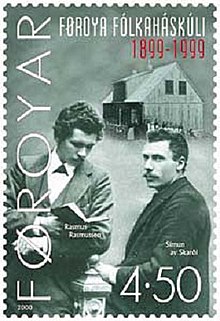
Back Literatura feroesa Catalan Færøsk litteratur Danish Färöische Literatur German Feroa literaturo Esperanto Literatura en feroés Spanish Fääri kirjandus Estonian Føroyskar bókmentir Faeroese Feröeri irodalom Hungarian Literatura farerska Polish Literatura das Ilhas Faroé Portuguese
This article includes a list of references, related reading, or external links, but its sources remain unclear because it lacks inline citations. (November 2019) |

Faroese literature, in the traditional sense of the word, has only really developed in the past two hundred years. This is mainly because of the islands' isolation, and also because the Faroese language was not written down in a standardised format until 1890. Until then the Danish language was encouraged at the expense of Faroese. Nevertheless, the Faroese language soon became a vehicle for literature in its own right and has produced writers in several genres.
No sagas were created in the Faroe Islands, but In the 13th century the Færeyinga saga (Saga of the Faroe Islanders) was written in Iceland. It tells the story of the settlement and early history of the Faroe Islands, though it is doubtful if it is entirely historically accurate. Faroese letters survive from the 13th and 14th centuries, and Faroese ballads were collected in the 17th century.
In the Middle Ages many poems and stories were handed down orally. These works were split into the following divisions: sagnir (legends), ævintyr (stories) and kvæði (ballads, traditionally sung along with the Faroese chain dance, in modern times also used in modern Faroese music). These kvæði were eventually written down in the 19th century. They are still used in Faroese dance without any use of instruments.
One of the first Faroese writers was the early 19th century liberal Nólsoyar Páll - Poul Poulson Nólsoy, who tried to end the trading monopoly that was affecting the islands. He wrote many poems, including his most famous work Fuglakvæði. Later poets include the brothers Janus and Hans Andreas Djurhuus, and Rói Patursson.
Other famous authors from the Faroes include Heðin Brú (The Old Man and His Sons), Jørgen-Frantz Jacobsen (who wrote in Danish and is known for his sole novel Barbara) and William Heinesen (The Black Cauldron), who also wrote in Danish.
Both Heinesen and Patursson were awarded The Nordic Council's Literature Prize.